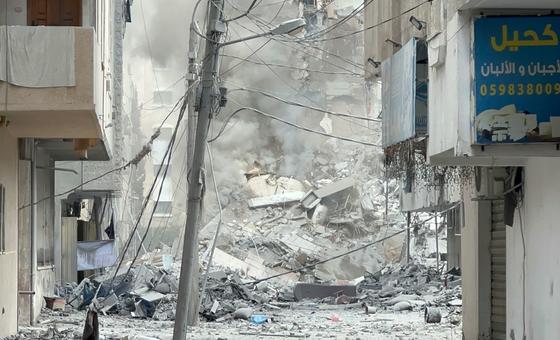“What we do know is that the health system is on its knees,” said Dr. Richard Peeperkorn, World Health Organization Representative in the Occupied Palestinian Territory, in the wake of Hamas militants’ terror attack on Israel on 7 October that left 1,200 dead and the heavy bombardment of the enclave by the Israeli military in response.
‘Endless need’
Speaking from Jerusalem to journalists in Geneva via Zoom, he explained that 47 out of 72 primary healthcare centres were no longer functioning and others were only partially functioning. Close to 75 per cent of hospitals (35 to 36) were no longer operational. “So there’s clearly not enough support for this endless need,” he said.
The development comes after the UN agency for Palestine refugees, UNRWA, reported a communications blackout in Gaza on Thursday as telecoms firms ran out of fuel to run their generators. The shutdown threatened to disrupt the coordination of humanitarian aid convoys on Friday, the UN agency said.
Rescue teams halted
Dr.Peeperkorn said that before the conflict erupted, Gazans had access to some 3,500 hospital beds. Today, only an estimated 1,400 are available, although the actual requirement is likely closer to 5,000. He added that in Gaza City, meanwhile, “active ground operations” “along with the lack of fuel, had halted the movement of rescue teams and ambulances in many areas”.
In its latest update on Thursday evening, the UN aid coordination office OCHA reported the previous24 hours had seen “heavy airstrikes, shelling and fighting”.
The bulletin detailed an airstrike on 15 Novemberat about 6pm “during the evening prayer time (in) the vicinity of the Ihya’ As Sunna Mosque in As Sabra neighbourhood” of Gaza City…reportedly killing 50 people and injuring others”.
The OCHA bulletin also updated information about Israeli troops and tanks that have been continuing their raid on the vast Al-Shifa hospital compound, reportedly takingcontrol of several sections. Cited the hospital’s director, the UN agency said that the southern section of the compound had been damaged “including the radiology department, and the forces took several corpses from within the hospital”.
Some 807,000 Palestinians remain in the north of the enclave, which represents about two-thirds of the population there before the latest escalation, according to OCHA. The other third of the population, about 400,000, have been likely displaced to the south.
“Hundreds of thousands” of those left in the north now shelter in public facilities, including schools, hospitals and with host families.
Soaring needs
As health needs soar, Dr.Peeperkorn said that a lack of fuel, water, food and medical supplies has made it harder for the hospitals and health facilities still “partially operational” to help them.
“WHO is extremely concerned about the spread of diseases as the rainy season and winter arrive. Overcrowding in shelters and the overall lack of water and sanitation across Gaza could increase the risk of transmission,” he said.
Citing data from the Gazan Ministry of Health, UNRWA and WHO, he added that there had been 71,224 recorded cases of acute respiratory infections, 44,202 cases of diarrhoea (22,554 in children under five), 808 cases of chickenpox, and more than 14,195 skin rashes, 10,952 cases of scabies and lice.
Weaponizing water
In a related development, a UN-appointed independent rights expert on Friday urged Israel to stop using water as a weapon of war.
Clean water and fuel needs to be allowed into Gaza to activate the water supply network and desalination plants in the besieged enclave “before it is too late”, said Pedro Arrojo-Agudo, UN Special Rapporteur on the human rights to safe drinking water and sanitation.
“Every hour that passes with Israel preventing the provision of safe drinking water in the Gaza strip, in brazen breach of international law, puts Gazans at risk of dying of thirst and diseases related to the lack of safe drinking water,” he said.

